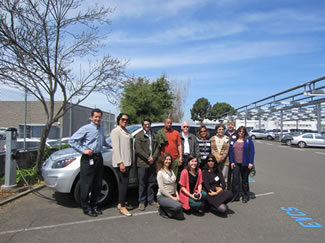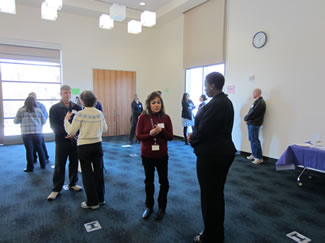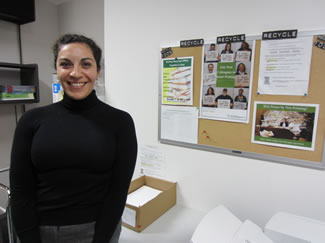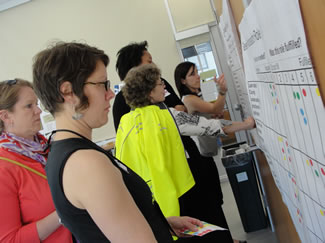Our Green Ambassadors
With 9,000 employees working for Alameda County, individual choices to conserve can add up to significant environmental savings. The Green Ambassadors pilot, coordinated by staff in the General Services Agency Sustainability Program, responds to requests made by employees in countywide surveys to learn more about opportunities to conserve at work � by providing information on simple actions employees can take.
Because person-to-person role modeling and encouragement is one of the most effective ways to get the word out on the simple things we can do each day, this project piloted a network of grassroots peer environmental educators known as Green Ambassadors. It is modeled on similar staff and student programs in many universities.
Pilot Summary
In order to effectively reach Alameda County's broad employee base, an enthusiastic pilot group of about 25 employee volunteers from 10 agencies were trained in opportunities to be green at work. They shared these with colleagues in their divisions during the course of their regular work and through focused campaigns. The pilot participants spent 2 to 3 hours a month to promote a featured green action through focused campaigns every other month from December 2012 through May 2013.
Pilot Outcomes

The Green Ambassadors carried out three campaigns that had positive outcomes:
- Informed dozens of their colleagues of the availability of many high-quality recycled-content office supplies;
- Organized smart printing workshops for 145 County employees and ran a contest that showed for every 60 people who pause to consider the necessity of printing, over 5000 pages can be saved; and
- Successfully led their agencies' participation in the May 2013 Clean Commute Challenge.
The Green Ambassadors pilot has formed a network and laid the foundation for grassroots employee leadership at Alameda County.
How to Replicate
Below are the general steps of how to set up a sustainability employee engagement program along with the specifics on how we piloted the program, the Green Ambassadors Network, at Alameda County. If you find the materials useful and would like to modify them for your organization, contact us for editable versions.
Step 1: Set up Parameters for Your Program
- Talk to others about the need for engagement
- We knew that in surveys and focused groups, County employees have consistently requested more opportunities and education to be green at work.
- Identify how the program relates to your goals
- In our case, these individual efforts, when aggregated, would help us reach the employee education and sustainability goals laid out in the County's Strategic Vision and Climate Action Plan.
- Develop program concept
- We wrote up a one-page document about the role of the Green Ambassadors. (PDF - 359kb) *
- We brainstormed possible campaign topics with staff working on topics that required employee involvement.
- Identify funding sources
- Our program required minimal funding for lunches for Green Ambassadors and gift certificate incentives for participants. We obtained funding for these items through Audubon's Toyota TogetherGreen Fellowship.
- Obtain needed approvals
- We received the go-ahead from our Climate Executive Committee (a group of County executives who guide implementation of the Climate Action Plan).
- Employees were asked to obtain supervisor approval to participate, and agency directors were informed of the program concept and goals.
Step 2: Recruit
There are many ways to recruit. We focused on word of mouth for our pilot.
- Reach out at events
- Sustainability staff running a sustainability information table at the Health Expo, an annual employee engagement event, reached out to employees who seemed particularly interested in the topic.
- Use referrals
- We called employees who were referred by other employees involved in climate projects.
- Follow up on prior interest
- We also called employees who had previously participated in sustainability initiatives.
- Reach out to potential candidates
- We interviewed employees who had been referred as potential candidates, asking them about their current level of engagement in sustainability at Alameda County, what improvements they would like to see, and if they were interested in being involved in a new employee engagement effort.
- Request applications
- Employees who wished to sign up filled out a short survey about their interests and goals.
Learning from Nature
During the Green Ambassadors Network Pilot we included training on biomimicry or lessons from nature and applied life's principles, which are overarching success strategies used by the species surviving and thriving on Earth.
For more information, review this poster or contact Alameda County Sustainability.
Step 3: Launch
We held a launch workshop to bring the Green Ambassadors together for the first time. It was an opportunity for them to meet other County employees with similar interests, discuss ways to promote being green at work, and finalize the role of Green Ambassadors.
- Build community and motivation
- The Green Ambassadors introduced themselves, sharing about the ecosystem where they grew up.
- We served lunch and allowed time for casual conversation.
- We brought in an exciting guest speaker who introduced the concepts of learning from nature about how to create successful networks.
- We made sure to include a hands-on exercise.
- Train the volunteers
- At the launch, the pilot group was trained in opportunities to be green at work, such as what the current sustainability policies and programs are.
- We clarified that their role would include: modeling new behaviors, providing colleagues with information about the impacts of their daily activities, and helping individuals take advantage of tools to make sustainability easier.
- We explained that there would be ongoing in-person trainings and check-in calls to launch new campaigns and check in on campaign outreach efforts.

- We included training on biomimicry, applying lessons from nature to human organizational change. Contact us for more information on how biomimicry was included in the pilot.

Step 4: Develop Campaigns
Employee volunteers were provided materials to engage colleagues in focused campaigns every other month. Topics were selected based on broad applicability across the organization and opportunities to complement existing initiatives, as well as interest of the Green Ambassadors. At trainings, the Green Ambassadors reviewed campaign concepts and gave input on the approach and materials needed.
- The first campaign encouraged employees to switch one office supply item to a recycled content version, to promote awareness of how easy and beneficial it is to choose recycled-content office supply items. Outreach materials:
- Email templates (PDF - 236kb) *
- Posters (PDF - 489kb) *
- Pledge sheets (PDF - 165kb) *
- FAQ (PDF - 348kb) *
- Tip sheet (PDF - 277kb) *
- The second campaign encouraged employees to use smart printing strategies and reduce paper use by participating in a smart printing contest and sharing tips. Outreach materials:
- Talking points (PDF - 223kb) *
- Email templates (PDF - 354kb) *
- Posters (PDF - 1397kb) *
- Presentation slides (PDF - 1124kb) *
- Online contest survey

- The third campaign encouraged employees to clean commute by attending the Clean Commute Fair, pledging to clean commute and participating in the Clean Commute Challenge. Outreach materials:
- Talking points (PDF - 399kb) *
- Email templates (PDF - 407kb) *
- Posters (PDF - 471kb) *
- Pledge tree
Step 5: Support Volunteers to Run Campaigns
Employee volunteers conducted campaign outreach using materials and tools provided by County Sustainability staff. The employees tailored the outreach efforts to fit their department's needs.
- Continue to train volunteers
- We held a training before each campaign. These were held at sites that showcased aspects of the County's green policies and included green building or project tours, which volunteers particularly enjoyed.
- Set up a system for tracking campaign outreach efforts
- We used a Google doc in which volunteers noted hours spent on outreach, people spoken with, materials posted, presentations given, number of people reached, etc.
- Hold check-in calls
- We convened Green Ambassadors halfway through each campaign so they could share their experiences and tips with each other.
Step 6: Refine Effort
Throughout the pilot, you will want to make adjustments based on outcomes and feedback from the volunteers. There were two approaches we found particularly helpful in promoting improvement and adjusting to the volunteers' needs.
- Hold site visits
- Green Ambassadors program staff coordinators went on site visits to the Green Ambassadors' workspaces, which served as opportunities to identify potential green opportunities firsthand, to check in on how the current campaign is going, and to review anything else the Green Ambassadors wanted to discuss.
- Collect input at in-person trainings
- After each campaign, we would discuss and record:
- What was your biggest challenge during the campaign?
- What was your biggest success during the campaign?
- What was effective with this campaign?
- What could be improved for this campaign?
- After each campaign, we would discuss and record:
Step 7: Evaluate Program
Evaluation enables you to assess what you have accomplished, what to continue, and what to change in the future.

- Track the outcomes
- We summarized our outcomes on each campaign, overall benefits reported, and time and resources invested.
- Celebrate your successes and thank your supporters
- We held a closing lunch to which supervisors and guests were invited.
- Hold a session with Green Ambassadors to consider key questions
- Green Ambassadors provided both written and group feedback to questions such as:
- What were the benefits of the Green Ambassadors network?
- To what extent do you recommend we continue this network?
- If we continue, what key changes should we make?
- Reflection worksheet (PDF - 422kb) *
- Green Ambassadors provided both written and group feedback to questions such as:
- Summarize feedback
- We sent the summary of information gathered back to the Green Ambassadors to ensure we captured all comments.
- Develop proposal based on feedback
- We met with other stakeholders to refine the proposal for next year and determine what resources were available.

Step 8
If your pilot is successful, you may expand and recruit more Ambassadors to join the network.
- Share role, responsibilities, and benefits with broader employee base
- We summarized our pilot on the County's intranet site and are encouraging more Ambassadors to join the network.
Related Resources
Articles Mentioning the Green Ambassadors Network
- "Local Impact," Sustainable Industries, 27 September 2012

